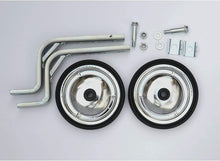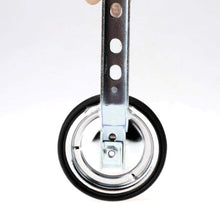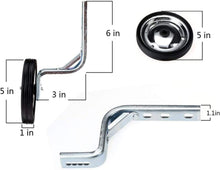
Training wheels are a popular tool for teaching young children how to ride a bike. They are adjustable and can fit onto bikes with wheel sizes ranging from 12-20 inches. Here are some important points to consider when using training wheels of this size:
- Safety: Training wheels provide a sense of security for children as they learn to balance and ride a bike. They prevent the bike from tipping over and reduce the risk of injury.
- Age range: 12-20 inch training wheels are typically designed for children between the ages of 2 and 6 years old. It is important to ensure that the bike and training wheels are appropriately sized for the child.
- Adjustability: Most training wheels are adjustable in height and angle, allowing them to be customized to the child's needs. It is important to properly adjust the training wheels to prevent the bike from leaning too much which could cause the child to lose their balance.
- Gradual removal: The goal of using training wheels is to teach the child how to balance and ride a bike on their own. As the child gains confidence, the training wheels can be gradually lifted off the ground to help them develop balance and coordination.
- Practice: Practice makes perfect. Children need to spend time practicing with the training wheels in order to learn how to balance and ride the bike. With patience and perseverance, they will eventually be able to ride without the training wheels.
- Support: It can be helpful to offer support and encouragement to children as they learn to ride. Praising even small accomplishments can help build confidence and motivate them to keep trying.
- Maintenance: It is important to regularly check the training wheels for wear and tear. They may need to be tightened or replaced if they become loose or damaged.
- Transitioning to a two-wheeler: Once the child is comfortable riding with the training wheels lifted off the ground, they can transition to a two-wheeler bike. This may take some time and practice, but with patience and support, most children are able to make the transition successfully.
Overall, training wheels can be a helpful tool for parents and children as they learn to ride a bike. The most important things to consider are safety, adjustability, and practice, as well as offering support and encouragement along the way.


Bicycle Training Wheels: How to Use Them to Teach Your Kids to Ride Without Them
Learning to ride a bicycle is a rite of passage for many children, and bicycle training wheels can be an invaluable tool in helping kids gain the confidence and balance necessary to ride on two wheels. In this article, we will discuss how to use training wheels effectively to help your child learn to ride a bike and offer some tips on when to consider using heavy-duty adult training wheels and specialized training wheels for special needs individuals.

When to Use Training Wheels
The age and weight at which a child is ready to use training wheels will vary depending on the child's physical development and coordination. Generally, children between the ages of three and six years old are good candidates for training wheels. As for weight, training wheels can typically accommodate children up to 75 pounds.

When choosing a bike, make sure it's the right size for your child. A bike that's too big or too small can make it more difficult to learn to ride. When your child sits on the bike, they should be able to touch the ground with both feet flat on the ground. The handlebars should be within easy reach, and the child should be able to reach the brakes comfortably.

How to Use Training Wheels
Before you attach the training wheels to the bike, make sure the bike is in good condition. Check the brakes, tires, and chain to ensure that everything is working properly. Next, attach the training wheels to the rear axle of the bike. Adjust the height of the training wheels so that they are just off the ground. You want them to provide stability to the bike, but you don't want the bike to lean too much to one side or the other.
Once the training wheels are attached, have your child sit on the bike and practice pedaling. Encourage them to steer and practice turning. As they become more comfortable, gradually raise the training wheels off the ground by a few millimeters. Continue to do this until the wheels are no longer touching the ground. The goal is to help your child gain the balance and coordination necessary to ride without training wheels.

Heavy Duty Adult Training Wheels
If you're an adult who is learning to ride a bike for the first time, or you're someone who needs extra support due to a physical disability or condition, heavy-duty adult training wheels can be a helpful tool. Heavy-duty training wheels are designed to support more weight and provide more stability than standard training wheels.

When to Consider Specialized Training Wheels
For individuals with special needs or disabilities, specialized training wheels can offer additional support and stability. For example, children with Down syndrome or other conditions that affect balance and coordination may benefit from training wheels that are wider and provide more stability. Other specialized training wheels may be designed for individuals who have limited mobility or use a wheelchair.

Conclusion
Bicycle training wheels can be an effective tool in helping children learn to ride a bike. When choosing a bike, make sure it's the right size for your child, and attach the training wheels so that they provide stability without leaning the bike too much to one side or the other. As your child becomes more comfortable, gradually raise the training wheels until they are no longer touching the ground. Heavy-duty adult training wheels and specialized training wheels can also offer additional support and stability for individuals with special needs or disabilities.







